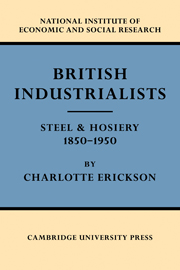Book contents
- Frontmatter
- Contents
- LIST OF TABLES
- Foreword
- Introduction
- I SCOPE OF THE INQUIRY
- II SOCIAL ORIGINS OF THE STEEL MANUFACTURERS
- III CAREERS OF THE STEEL MANUFACTURERS
- IV SOCIAL ORIGINS OF THE NOTTINGHAM HOSIERS
- V CAREERS OF THE HOSIERY MANUFACTURERS
- VI THE INTRODUCTION OF NEW TECHNIQUES IN STEEL-MAKING
- VII HOSIERY INNOVATORS
- VIII THE PUBLIC COMPANY
- Appendix A Selection of firms
- Appendix B List of firms included in steel study
- Appendix C Selection of men for steel study
- Appendix D The hosiery samples
- Appendix E Classification of fathers' occupations
- Appendix F Notes on comparisons with Population Census
- Appendix G Education
- Appendix H Marriages
- Appendix I Careers
- Appendix J Public company tables
- List of Principal Works Cited
- Index of names
- Index of companies
- General index
- PUBLICATIONS OF THE NATIONAL INSTITUTE OF ECONOMIC AND SOCIAL RESEARCH
VI - THE INTRODUCTION OF NEW TECHNIQUES IN STEEL-MAKING
Published online by Cambridge University Press: 07 October 2011
- Frontmatter
- Contents
- LIST OF TABLES
- Foreword
- Introduction
- I SCOPE OF THE INQUIRY
- II SOCIAL ORIGINS OF THE STEEL MANUFACTURERS
- III CAREERS OF THE STEEL MANUFACTURERS
- IV SOCIAL ORIGINS OF THE NOTTINGHAM HOSIERS
- V CAREERS OF THE HOSIERY MANUFACTURERS
- VI THE INTRODUCTION OF NEW TECHNIQUES IN STEEL-MAKING
- VII HOSIERY INNOVATORS
- VIII THE PUBLIC COMPANY
- Appendix A Selection of firms
- Appendix B List of firms included in steel study
- Appendix C Selection of men for steel study
- Appendix D The hosiery samples
- Appendix E Classification of fathers' occupations
- Appendix F Notes on comparisons with Population Census
- Appendix G Education
- Appendix H Marriages
- Appendix I Careers
- Appendix J Public company tables
- List of Principal Works Cited
- Index of names
- Index of companies
- General index
- PUBLICATIONS OF THE NATIONAL INSTITUTE OF ECONOMIC AND SOCIAL RESEARCH
Summary
Different as they were, and are in most respects, the hosiery and steel industries had one thing in common. They both experienced revolutionary technological innovations during the third quarter of the nineteenth century. The application of power to the stocking frame and the movement of production from the homes of framework knitters in scattered villages to factories in larger towns and cities took place much later than in the spinning and weaving branches of textile industries. Production of heavy steel became an important activity only after Bessemer, Mushet, Siemens and Thomas had shown how steel could be made on a large scale.
The data obtained in this investigation make it possible to describe the firms and men who led the adoption of new methods. So far in this study, the 1865 steel-makers and the 1871–9 Nottingham hosiers have been characterized rather loosely as the ‘innovating generation’. In general it was found that social recruitment to steel firms did not reveal the increased mobility that Alfred Marshall's hypotheses would have led one to expect. In the smaller-scale hosiery industry, on the other hand, the factory industry attracted a higher proportion of men from the crafts which had serviced the domestic industry, than had merchantcapitalist production before the triumph of the factory. These results do not discriminate between innovators and imitators; nor do they tackle the question of the relative success, as measured by the longevity of the firm or the innovator's career in it.
- Type
- Chapter
- Information
- British IndustrialistsSteel and Hosiery 1850–1950, pp. 139 - 170Publisher: Cambridge University PressPrint publication year: 1959



